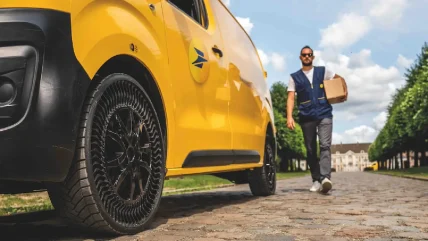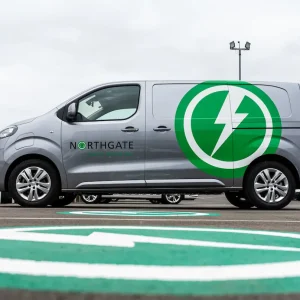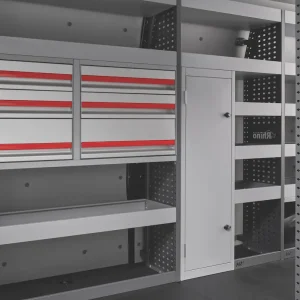
Apollo, Bandag, Boto, Kenya, Next Tread, Pinso Rovelo, Saetta, Triangle… Nobody truly knows the precise number of tyre brands – including many you’ve never even heard about – that are sold in the UK, but it’s estimated at 700 plus. That results in a bewildering choice for retailers and van drivers alike, according to industry experts.
The International Tyre Manufacturers’ Association (ITMA) quotes some 41 million car and commercial tyres were replaced last year (excluding the five million part-worn alternatives). And that figure would be considerably higher if it weren’t for the fact that, according to ITMA, up to 40% of all discarded tyres were in an illegal state by then.
In fact, data compiled by Halfords reveals the number of vehicles running on tyres below or on the borderline of the minimal legal tread of 1.6mm depth leapt by a staggering 71% compared with last year.
Hardly inexpensive, van tyres are in real world terms cheaper than ever, even though they have grown in size and performance over recent years. Cut throat competition keeps prices competitive; 40 years ago, a typical best brand 155 x13 radial as fitted to the Bedford (Vauxhall) Astramax for instance was ticketed around the £40 mark (£124 in today’s money, according to the Bank of England). In contrast, a search on the web unearths the much fatter modern 185/60 x15 equivalent from under £100 for a premium Yokohama, with lesser brands retailing at half of this.
When the time does come to replace your van’s tyres you have essentially four choices to make: premium, mid-range and economy brands, and part-worn tyres.
Premium
As the term implies, these are best known branded household name tyres, fitted by the factory and at the forefront of tyre technology. By and large these state-of-the-art designs will possess the best of everything: grip, noise level, comfort, fuel efficiency and wear rate. Michelin says its van range is effectively a series of de-tuned truck tyres rather than upgraded car tyres that are specifically designed to survive van life. Bridgestone, which has just launched its new EV ready Duravis van tyre, says, “86% of drivers listed ‘wet performance’ as one of the most important aspects when purchasing replacements.”
“Budget [brands] may be ‘A’ rated in one area but would likely offset this with poor performance elsewhere,” Bridgestone’s technical manager, Gary Powell, warns.
Mid range
Self explanatory, this sector sits between the top names and the economy tyres. Some names have become quite well known. Celebrating 40 years of tyre making, Falken has been elevated to original equipment status by Mercedes-Benz no less. “[We are] often embarrassing more expensive rivals in the respected independent tyre tests in Germany and the UK,” claims Andreas Giese, chief corporate officer at Falken Tyres Europe.
A fair number of mid-range tyre manufacturers are in fact second-tier brands made by the big boys. A prime example is Michelin which also markets Polish made Kormanan and Tigar.
For those operating older vehicles with an eye on costs but still wanting acceptable performance, a good mid-range tyre makes an ideal compromise, a point made by Kumho Tyre UK’s marketing director, John Thrupp. “While the old adage of ‘you get what you pay for’ generally holds true, there remains a huge gulf in quality between the best
and worst performing products on the market, with the biggest brand names
not always finishing on top of the pile.”
Budget tyres
This is where some of the oddest names lurk. Price aside, another reason for the surge in popularity of economy brands is their improving performance and quality levels. Although some remain better than others, which is why you must take notice of the independently supplied information contained on every tyre label. Far from being fringe buys, economy brands (that’s budget and mid-range combined) account for well over half of all UK tyre sales.
How good is a good ‘budget or mid-range’ tyre? As one distributor (Tyre-warehouse.co.uk) puts it on its website: “Budget manufacturers can be just as good as a premium tyre that came out a few years ago.” They probably won’t possess the best overall grip, but for those who don’t drive around like the archetypal mythical white van man they may prove more than adequate and a safer bet than buying a used tyre.
Part-worn tyres
Aside from the possibility of buying a bad tyre, you should also question the economic value of a part-worn tyre, as one with only half of its life left represents dubious value. For example, a 4mm tread depth is good for 10,000 miles maximum, according to the RAC. In contrast, fleets with Michelin’s Agilis 3 LCV tyre have mileages of up to 80,000 miles before wearing down to a similar level, according to Martin Thompson, Michelin’s AGB brand manager, UK and Ireland.
Top 10 Tyre Tips
While CDVs normally happily run on conventional tyres, larger vans coping with heavier loads use dedicated commercial tyres, signified by the letter C on the sidewall or XL (Extra Load) and RF (Reinforced) to cope with loads up to or exceeding 3.5 tonnes. Fitting normal passenger car tyres (even if you only carry light loads) may infringe your insurance cover if you’re involved in an accident.
Tyres degenerate, which is why they have a shelf life of around six years before replacement is recommended. You can ascertain a tyre’s age by looking on the sidewall. Revised markings were used after 2000, with four-digit numbers showing the month followed by year. For example ‘0713’ means month seven,July, 2013.
Don’t just rip off the tyre label as many do, as it displays (via independent tests) information like wet weather performance, noise, fuel savings and so on to help you make the best decision.
Try not to mix and match tyres and at least not on the same axle, as individual makes have different compounds and can vary in rolling radius. This could cause havoc not only with the handling and road-holding, but also the performance and durability of limited slip differentials and all AWD transmissions.
Tyre rotation to even out wear rates is bad practice as each tyre adapts to its particular axle. Swapping around will affect the steering and handling.
A dying art, but regular inspections are vital as condition can also be a barometer for various problems. Excessive wear in the centre shows over-inflation, while conversely too much on the edges signals under-inflation, and irregular wear on one side points towards steering geometry and suspension issues. Also look for sidewall cracking, bulges and kerbing damage.
Although UK law demands a tread depth of no less than 1.6mm across the central three-quarters of the tyre (throughout its circumference), many regard 2mm as a more sensible limit as wet weather performance reduces drastically once past 3mm. According
to Kwik-Fit, defective tyres account for at least 10% of all MOT failures.
Commercial vehicles are well known for mounting kerbs and such like, which shortens tyre life and impairs handling. Consider having a professional all wheel alignment check annually as part of a tyre management plan.
In the UK, we mostly rely on summer tyres. The short-lived seasonal switch from summer to winter tyres has largely petered out, now accounting for less than 1% of the tyre market. It’s quickly being superseded by all-season tyres (identified by a triple mountain alpine symbol) which, while not so good in severe winter conditions, provides a better all year-round compromise.
With so many brands on the market, how can motorists cut through the confusion and purchase the best tyre for their needs and budget?
One solution is WhatTyre, a unique tyre comparison engine that educates consumers at the pre-sale research stage. This database of over 300,000 tyres compares tyre label data with thousands of third-party magazine tyre tests as well as OE and ESG details to help customers choose a tyre based on what it does, not just what it costs.
Airless tyres
We’ve had air and nitrogen filled tyres and run flats, but now airless? Michelin is currently conducting trials with the 40-strong French La Poste fleet using its new Uptis tyre, which is specifically aimed at delivery fleets. Puncture proof and largely maintenance-free, Michelin says it’s a step towards its goal of a fully sustainable tyre by 2050.
Kwik-Fit
Dan Joyce, fleet director at Kwik Fit, says: “Recent fleet data shows that while company cars are covering fewer miles over their contract term than in previous years, vans are being driven a lot further. At Kwik Fit, we have been supporting fleets for over 35 years. Across our national network of 700 centres, we have sites focused on holding large stocks of the most common LCV tyres, and our latest developments allow van drivers to see live appointment and stock availability. Also, Kwik Fit’s mobile network enables us to come to them, either on site or at home at times when their van is not being used.”





